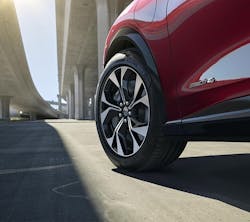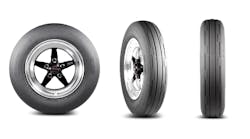Electric Vehicles Are Here to Stay: But Do You Know What 'Goes Into' An EV Tire?
California Governor Gavin Newsom recently made headlines when he issued an executive order that mandates the phase-out of the sale of new, gasoline-powered cars, CUVs and SUVs in “The Golden State” by the year 2035.
Cynics among us might dismiss the announcement as a carefully timed bit of political grandstanding, while others will interpret it as a genuine attempt by an elected official to curb the devastating impact of climate change.
Regardless of your personal or political stance, Newsom’s well-publicized order only underscores the fact that electric passenger vehicles are here to stay.
According to the United States Department of Energy, more than 325,000 electric passenger vehicles were sold in the U.S. in 2019, the second highest number on record. Since 2011, more than 1.4 million EVs have been sold in the U.S.
Now, will EVs be adopted by the mainstream motoring public as quickly as some proponents suggest? I’m somewhat skeptical. There are numerous, still-unanswered questions about electric vehicle design, range and cost; the infrastructure needed to support such a profound shift; and good, old-fashioned consumer demand. (For instance, I don’t see EV sales “taking off” in rural areas - where drivers could easily drain a battery running weekend errands - anytime soon.)
However, there’s no doubt you will see more of these vehicles rolling into your dealership in the coming years, as several tire manufacturers have already pointed out. As such, you and your team will need to be prepared to service and replace the tires that electric vehicle manufacturers will continue to spec for these machines.
With that in mind, I thought it would be interesting to find out what electric car manufacturers are looking for in terms of original equipment tires.
Ford Motor Co. put me in touch with Rob Iorio, vehicle engineering manager for the company’s all-electric Mustang Mach-E SUV, which will be available for purchase soon. (The Mach-E will have a targeted range of at least 300 miles per charge in rear-wheel drive options, according to Ford.)
Iorio discussed how Ford addressed several areas of performance when specifying tires for the vehicle. First up was making the Mach-E as aerodynamic as possible. (Yes, the dimensions of a tire can play a role in achieving this dynamic, he confirmed.)
“We looked at every bit of the (car’s) surface area,” he said. “That’s where we started. We also looked at the turn circle. We wanted to be able to turn the tires given the mass of the vehicle. We ended up with 225 mm of width,” as well as requesting a tire with an outside diameter of 730 mm.
Load carrying capacity was another priority. “We had to ensure that we could find properly rated tires” to support the Mach-E, which is heavier than gas-powered counterparts.
“All EVs that carry these batteries are heavy,” noted Iorio. “It’s a fact of life. We have a brand new suspension (system) in the rear and a typical Macpherson strut in the front. It became an engineering challenge for us.”
Iorio’s team also considered tire wear, although he admits this was a lesser priority. “We monitor wear. It’s something we want to keep an eye on. But as long as our alignments are set to provide the performance that our stability control team wants, we feel pretty confident.” (When asked if Ford requested a tire with extra tread depth, he said, “No.”)
Achieving a balance between road, powertrain and wind noise was critical. All three needed “to come in equally and be harmonious,” noted Iorio. “You never want one to stand out. When we found the tread we wanted, we made sure we tried to tune that.”
Adequate grip rounded out Ford’s wish list. “Everybody wants to have a great range, yet they also want grip to get all that torque” when an EV “comes off the line when the light turns green,” to paraphrase an old Beach Boys tune.
“You don’t want tires to slip, but you also want to have good longitudinal rolling resistance. That’s another balance with EVs.”
Performance trade-offs have always been part and parcel of tire design. Minimizing those trade-offs is an aspiration of every tire manufacturer.
When specifying tires for EVs, “there are more factors we have to take into account because of the mass of the vehicle, because of the proportions of the vehicle, because of the way (the vehicle) uses energy,” says Iorio. “It’s a more complex solution. We have to make decisions one way or another, but we optimize for a solution that we feel is really good.”
Make sure you file away the above information before you start to see the Mustang Mach-E - and other electric vehicles - at your dealership. It will come in handy.




